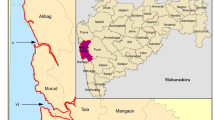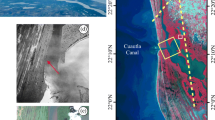Abstract
Bangladesh, at the confluence of the sediment-laden Ganges and Brahmaputra Rivers, supports an enormous and rapidly growing population (>140 million in 2011), across low-lying alluvial and delta plains that have accumulated over the past few thousand years. It has been identified as one of the most vulnerable places in the world to the impacts of climate change and sea-level rise. Although abundant sediment supply has resulted in accretion on some parts of the coast of Bangladesh, others are experiencing rapid erosion. We report a systematic assessment of rates of shoreline change over a 20-year period from 1989 to 2009, using Landsat satellite images with pixel resolution of 30 m on the ground. A Band ratio approach, using Band-5 divided by Band-2, discriminated the water line on images that were largely cloud-free, adequately registered, and at comparable tidal stages. Rates of shoreline change were calculated for >16,000 transects generated at 50 m intervals along the entire mainland coastline (>1,100 km) and major islands, using the End Point Rate (EPR) method in the Digital Shoreline Analysis System (DSAS) extension in ArcGIS®. Erosion characterises most of the seaward margin of the Sundarbans in western Bangladesh. Retreat rates of up to 20 m/yr are typical, with little evidence that local devastation of the mangrove fringe by Cyclone Sidr in November 2007 had resulted in uncharacteristic long-term rates of retreat where it made landfall. Erosion exceeded accretion in the Barguna Patuakhali coastal zone, most of which eroded at up to 20 m/yr, but with truncation of the southern tip of the Patharghata Upazila at up to 100 m/yr. In Bhola, erosion at rates of up to 120 m/yr were observed along much of the coast, but in the Noakhali Feni coastal zone, similar rates of erosion were balanced by rapid accretion of the main promontory by more than 600 m/yr. Rates of change were more subdued in the Chittagong and Cox’s Bazar coastal zones of southeast Bangladesh. Islands in the Meghna estuary were especially dynamic; Hatiya Island accreted along some of its shoreline by 50 km2 between 1989 and 2009, but lost 65 km2 through erosion elsewhere, resulting in the island moving south. Similar trends were observed on adjacent islands. The overall area changed relatively little across the entire coastline over the 20-year period with accretion of up to 315 km2, countered by erosion of about 307 km2.






Similar content being viewed by others
References
Alesheikh AA, Ghorbanali A, Nouri N (2007) Coastline change detection using remote sensing. Int J Environ Sci Technol 4:61–66
Allison MA (1998a) Geologic framework and environmental status of the Ganges-Brahmaputra delta. J Coastal Res 14:826–836
Allison MA (1998b) Historical changes in the Ganges-Brahmaputra delta front. J Coastal Res 14:1269–1275
Allison MA, Kepple EB (2001) Modern sediment supply to the lower delta plain of the Ganges-Brahmaputra River in Bangladesh. Geo-Mar Lett 21:66–74
Bala B, Hossain M (2010) Modeling of food security and ecological footprint of coastal zone of Bangladesh. Environ Dev Sustain 12:511–529
Barua DK (1997) The active delta of the Ganges-Brahmaputra rivers: dynamics of its present formations. Mar Geod 20:1–12
BBS (2011) Population and housing census 2011: preliminary results. Bangladesh Bureau of Statistics (BBS), Ministry of Planning, Government of the People’s Republic of Bangladesh, Dhaka
Begum S, Fleming G (1997) Climate change and sea level rise in Bangladesh, part II: effects. Mar Geod 20:55–68
Benny AH (1980) Coastal definition using Landsat data. Int J Remote Sens 1:255–260
Cruz RV, Harasawa H, Lal M, Wu S, Anokhin Y, Punsalmaa B, Honda Y, Jafari M, Li C, Ninh NH (2007) Asia. In: Parry ML, Canziani OF, Palutikof JP, Linden PJ, Hanson CE (eds) Climate change 2007: impacts, adaptation and vulnerability. Contribution of working group II to the fourth assessment report of the intergovernmental panel on climate change. Cambridge University Press, Cambridge, pp 469–506
Frazier PS, Page KJ (2000) Water body detection and delineation with Landsat TM data. Photogramm Eng Remote Sens 66:1461–1467
Giri C, Pengra B, Zhu Z, Singh A, Tieszen LL (2007) Monitoring mangrove forest dynamics of the Sundarbans in Bangladesh and India using multi-temporal satellite data from 1973 to 2000. Estuar Coast Shelf Sci 73:91–100
Goodbred SL (2003) Response of the Ganges dispersal system to climate change: a source-to-sink view since the last interstade. Sediment Geol 162:83–104
Goodbred SL, Kuehl SA (1998) Floodplain processes in the Bengal Basin and the storage of Ganges-Brahmaputra river sediment: an accretion study using 137Cs and 210Pb geochronology. Sediment Geol 121:239–258
Goodbred SL, Kuehl SA (1999) Holocene and modern sediment budgets for the Ganges-Brahmaputra river system: evidence for highstand dispersal to flood-plain, shelf, and deep-sea depocenters. Geol 27:559–562
Goodbred SL, Kuehl SA (2000a) Enormous Ganges-Brahmaputra sediment discharge during strengthened early Holocene monsoon. Geol 28:1083–1086
Goodbred SL, Kuehl SA (2000b) The significance of large sediment supply, active tectonism, and eustasy on margin sequence development: late quaternary stratigraphy and evolution of the Ganges-Brahmaputra delta. Sediment Geol 133:227–248
Himmelstoss EA (2009) DSAS 4.0 installation instructions and user guide. In: Thieler ER, Himmelstoss EA, Zichichi JL, Ergul A (eds) Digital shoreline analysis system (DSAS) version 4.0 — an ArcGIS extension for calculating shoreline change. U.S. Geological Survey (USGS)
Hoque M, Alam M (1997) Subsidence in the lower deltaic areas of Bangladesh. Mar Geod 20:105–120
Islam MR, Begum SF, Yamaguchi Y, Ogawa K (1999) The Ganges and Brahmaputra rivers in Bangladesh: basin denudation and sedimentation. Hydrol Process 13:2907–2923
Jimenez JA, Sanchez-Arcilla A, Bou J, Ortiz MA (1997) Analysing short-term shoreline changes along the Ebro delta (Spain) using aerial photographs. J Coast Res 13:1256–1266
Karim MF, Mimura N (2008) Impacts of climate change and sea-level rise on cyclonic storm surge floods in Bangladesh. Glob Environ Chang 18:490–500
Marfai M, Almohammad H, Dey S, Susanto B, King L (2008) Coastal dynamic and shoreline mapping: multi-sources spatial data analysis in Semarang Indonesia. Environ Monit Assess 142:297–308
Michels KH, Kudrass HR, Hübscher C, Suckow A, Wiedicke M (1998) The submarine delta of the Ganges-Brahmaputra: cyclone-dominated sedimentation patterns. Mar Geol 149:133–154
Mikhailov VN, Dotsenko MA (2007) Processes of delta formation in the mouth area of the Ganges and Brahmaputra rivers. Water Resour 34:385–400
Nicholls RJ, Wong PP, Burkett VR, Codignotto JO, Hay JE, McLean RF, Ragoonaden S, Woodroffe CD (2007) Coastal systems and low-lying areas. In: Parry ML, Canziani OF, Palutikof JP, Linden PJ, Hanson CE (eds) Climate change 2007: impacts, adaptation and vulnerability, contribution of working group II to the fourth assessment report of the intergovernmental panel on climate change. Cambridge University Press, Cambridge, pp 315–356
O’Connor MC, Cooper JAG, McKenna J, Jackson DWT (2010) Shoreline management in a policy vacuum: a local authority perspective. Ocean Coast Manag 53:769–778
Rahman AF, Dragoni D, El-Masri B (2011) Response of the Sundarbans coastline to sea level rise and decreased sediment flow: a remote sensing assessment. Remote Sens Environ 115:3121–3128
Rashid T, Suzuki S, Sato H, Monsur MH, Saha SK (2013) Relative sea-level changes during the Holocene in Bangladesh. J Asian Earth Sci 64:136–150
Sarwar GM, Khan MH (2007) Sea level rise: a threat to the coast of Bangladesh. Internationales Asien forum. Int Q Asian Stud 38:375–397
UNFPA (2011) Population projection 2021. United Nations Population Fund Association (UNFPA). http://www.unfpa-bangladesh.org/charts/PopulationProjection2021.htm. Accessed on 12 October 2011
WARPO (2006) Coastal development strategy. Water Resources Planning Organization (WARPO), Ministry of Water Resources, Government of the People’s Republic of Bangladesh, Dhaka
Warrick RA, Ahmad QK (eds) (1996) The implications of climate and sea level change for Bangladesh. Kluwer Academic Publishers, Dordrecht
White K, Asmar E, Hesham M (1999) Monitoring changing position of coastlines using Thematic Mapper imagery, an example from the Nile delta. Geomorphology 29:93–105
Woodroffe CD, Nicholls RJ, Saito Y, Chen Z, Goodbred SL (2006) Landscape variability and the response of Asian megadeltas to environmental change: the Asia-Pacific Region. In: Harvey N (ed) Global change and integrated coastal management. Springer, The Netherlands, pp 277–314
World Bank (1990) Bangladesh-Muhuri Irrigation Project, ID- P009380, Project completion Report, No-8555, Washington DC
Acknowledgments
This research was undertaken using the resources of the Spatial Analysis Lab (SAL) at the School of Earth and Environmental Sciences, University of Wollongong, while MGMS held an Australian Leadership Award (ALA) sponsored by AusAID. We are grateful to Brian Jones for his advice and guidance.
Author information
Authors and Affiliations
Corresponding author
Rights and permissions
About this article
Cite this article
Sarwar, M.G.M., Woodroffe, C.D. Rates of shoreline change along the coast of Bangladesh. J Coast Conserv 17, 515–526 (2013). https://doi.org/10.1007/s11852-013-0251-6
Received:
Revised:
Accepted:
Published:
Issue Date:
DOI: https://doi.org/10.1007/s11852-013-0251-6




